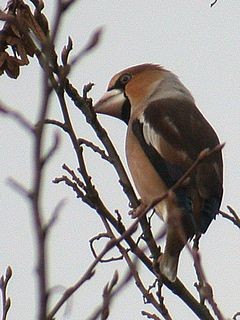The Hawfinch is a secretive species with which few of us can claim to be familiar. A striking bird, and a tricky species to see, this elusive finch can take quite a bit of effort to secure decent views of and they are high on the 'most wanted' list of many birders.

Photo: Margaret Breaks
An uncommon resident in the UK, with a breeding population estimated to be between 3,000-6,500 pairs, it is scarce to the north and west of the preferred strongholds in the south of the country. A recent study of the status of the Hawfinch in the UK (Langston et al., 2002) found that Hawfinches have declined in many counties by between 2% and 27% over a recent 20-year period, and by 37-45% during a recent 10-year period. It is presently on the 'amber list' of Birds of Conservation Concern, though declines in former strongholds of the species have raised even further concerns. Indeed, many sites which reported good numbers as recently as the 1980s are now devoid of birds. However, against these depressing statistics are reports that there have been population increases in counties such as Gloucestershire, Gwent and Wiltshire, and in some counties in the Midlands.

Distribution of Hawfinch records by county, winter 2002/03.
The sites around the UK at which it is possible to see this declining species are becoming few and far between. Winter is the best time of the year to observe birds, when they form small flocks in the canopy and often congregate at regular roosting sites. The best way to see birds is pick them up in flight, when they utter a distinctive 'ticking' call, and then hope that they alight in the tops of some tall trees.
Use the Bird News Extra search page for up-to-date information, and to search for sightings in your area. Enter Hawfinch and the area you are interested in sightings for. In addition there are a number of 'traditional' sites from which there have been no recent reports – why not try and visit some of these and contribute to our knowledge regarding the current status of these fantastic birds?
During the winter 2002/2003 at least 207 birds have been reported from a number of sites, but the following locations have provided regular sightings:
- Hutton, Cleveland: NZ598145 – Up to 5 in the grounds of Hutton Hall, viewed from road to Hutton village NZ598145, also up to 3 next to School House.
- Llanbedr-y-cennin, Conwy: SH761696 – Up to 11 present. Scan the treetops around the chapel SH761696.
- Caerhun, Conwy: SH773705 – Two birds have been present. Park near the churchyard and scan the treetops.
- Cromford, Derbyshire: SK300573 – Up to 6 have been seen at the entrance to Willesley Castle. Scan gardens and woodland east of the river around the entrance to Willesley Castle and Cromford Bridge Hall school.
- Parkend (Forest of Dean), Gloucestershire: SO6108 – Up to 20 this winter around the Beech trees below the church. Birds are also seen in woodland by the Speech House Hotel SO620121, by the B4426 halfway between Cinderford and Coleford. Elsewhere, birds have been at Brierley SO623149 and at Nagshead RSPB reserve SO097085. Early in 2001 up to 126 birds were seen around The Rising Sun public house SO631086 in Moseley Green.
- Blackwater Arboretum, Hampshire: SU268047 – Up to 20 have been seen at roost during the winter. Park by Black Water brook in the Rhinefield car park and walk across the road to the arboretum and stand just inside the gate to view birds coming to roost.
- Romsey, Hampshire: SU357217 – Up to 6 have been seen in trees at end of Mercer Way SU357217.
- Bedgebury Pinetum, Kent: TQ718335 – Up to 6 present, roosting near marker post 15 TQ720338. There is a £3 entry charge to the site and the Pinetum shuts at 16:00 in winter.
- Trosley CP, Kent: TQ645615 – Up to 8 present during the winter.
- Brierfield, Lancashire: SD855368 – 3 at Edge End Clough by 'The Beeches' bungalow SD855368
- Woodwell, Lancashire: SD462744 – Up to 12 this winter. Park by R. Kaye Plant Nursary in Silverdale SD462744 and walk up the minor road signposted to 'Woodwell' (marked on OS maps as a footpath). Scan all the treetops in this area - the tall trees just before 'The Elms' (the last house on the right along this minor road) are often productive. Also, continue past the houses to check treetops around the parking/turning area at the end of the minor road SD465744.
- Barnhamcross Common, Norfolk: TL870816 – Up to 9 have been present by the pumping station TL870816.
- Lynford Arboretum, Norfolk: TL820936 – Up to 8 have been seen at this well known site recently. To view the hornbeams favoured by the Hawfinches walk south through the arboretum and over the lake and view the trees in the paddock, in the vicinity of TL820936.
- Hulne Park (Alnwick), Northumberland: NU179145 – At least 3 have been present this winter, favouring the area just inside the entrance to the park on the B6346, just northwest of Alnwick.
- Clumber Park, Nottinghamshire: SK629748 – Up to 12 have been seen this winter, favouring the area behind the chapel SK629748.
- Blenheim Palace, Oxfordshire: SP4416 – Up to 12 have been seen recently (though there were no records between 1995 and 1999). The best area is the Palace Garden, visible from the miniature railway. For quickest access to the Palace Gardens, use the Old Woodstock SP441172 or Bladon SP447151 entrances. For more details see: http://www.oos.org.uk/Sites/Blenheim.htm
- Scone Palace, Perth and Kinross: NO117268 – There have been 14 recently. A favoured area is by the side entrance avenue of trees to the Palace at NO117268.
References
Langston R, Gregory R, Adams R. 2002. 'The Status of the Hawfinch in the UK 1975-1999.' British Birds 95:166-173
Map created with DMAP.


